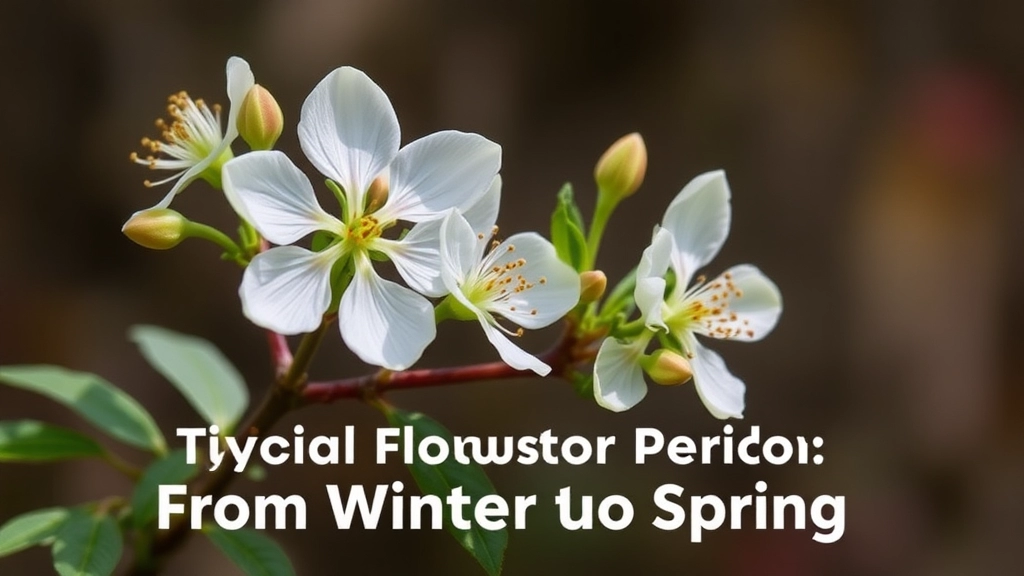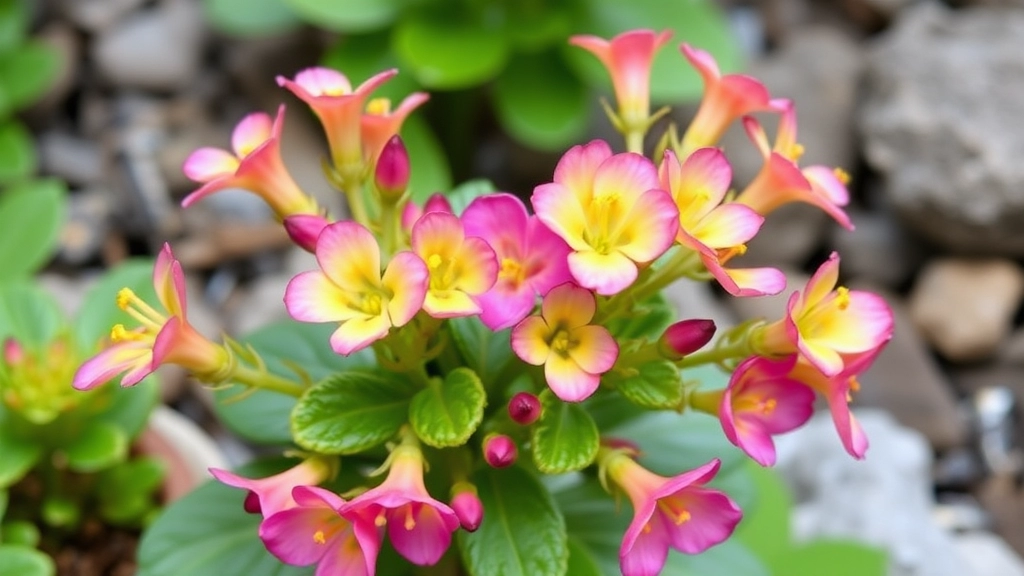Kalanchoe Blossfeldiana Flowering Period
When it comes to the Kalanchoe Blossfeldiana flowering period, understanding the optimal conditions can make all the difference. Typically, this vibrant plant blooms from winter to spring, thriving in bright, indirect light and well-draining soil. To encourage reblooming, it’s crucial to mimic natural light cycles and ensure the plant gets 14 hours of darkness each day.
Optimal Care Tips
- Watering: Adjusting watering habits is key; overwatering can hinder flowering. Instead, let the soil dry out between waterings.
- Pruning: Pruning and deadheading spent flowers can promote longer blooming periods.
- Preventing Issues: By preventing common issues such as root rot and pests, you can maximize the lifespan of your Kalanchoe blooms, whether indoors or outdoors.
Optimal Conditions for Kalanchoe Blossfeldiana to Bloom
Are you struggling to get your Kalanchoe Blossfeldiana to bloom? You’re not alone. Many plant enthusiasts face challenges when trying to coax these vibrant flowers into full bloom.
To achieve optimal blooming conditions for Kalanchoe Blossfeldiana, consider the following factors:
- Light: Kalanchoe thrives in bright, indirect sunlight. Aim for around 6 hours of light daily. Too little light can hinder blooming, while too much direct sunlight may scorch the leaves.
- Temperature: These plants prefer temperatures between 18°C to 24°C (65°F to 75°F). Avoid exposing them to drafts or sudden temperature changes, which can stress the plant.
- Soil: Use well-draining soil with a slightly acidic to neutral pH. A cactus or succulent mix works wonders, allowing for proper drainage while retaining some moisture.
- Fertiliser: A balanced, water-soluble fertiliser can be applied every 2-4 weeks during the growing season. This provides essential nutrients to support blooming.
- Watering: Water thoroughly but infrequently. Allow the soil to dry out between waterings to prevent root rot. Overwatering is a common mistake that can lead to poor blooming.
By ensuring these optimal conditions, you set the stage for a stunning display of Kalanchoe blooms. For more detailed advice, check out our Optimal Care for Kalanchoe Blossfeldiana Growth guide. Additionally, if you’re interested in propagation techniques, our How to Propagate Kalanchoe Blossfeldiana Cuttings article provides step-by-step instructions.
Typical Flowering Period: From Winter to Spring

So, you’re wondering when your Kalanchoe Blossfeldiana will burst into bloom?
Well, these vibrant little beauties typically flaunt their flowers from winter to spring.
This timing can feel like a breath of fresh air during the colder months when everything else seems a bit dull.
Why Winter to Spring?
- Natural Rhythm: Kalanchoes are programmed to bloom when days start getting longer.
- Light Exposure: As winter gives way to spring, the increasing light levels signal the plant to kick into gear.
Imagine the excitement of watching your Kalanchoe transform your space with its colourful blooms just when you need it most!
What to Expect
During this flowering period, you can expect:
- Vibrant colours: From reds to pinks and yellows, the range is stunning.
- Duration: Blooms can last for several weeks, sometimes even months with the right care.
But what if your Kalanchoe isn’t blooming as expected? Don’t fret!
After enjoying the vibrant display of Kalanchoe Blossfeldiana’s initial flowering, many plant lovers wonder how to coax their beloved succulent into another bloom.
Kalanchoe thrives on care that mimics its natural habitat. Here are some practical steps to encourage reblooming:
– **Post-Bloom Care**: Once the flowers fade, it’s essential to trim back the spent blooms. This process, known as deadheading, redirects the plant’s energy towards new growth rather than seed production.
– **Light Requirements**: Ensure your Kalanchoe receives bright, indirect sunlight. A south-facing window is ideal. If natural light is limited, consider using grow lights.
– **Watering Schedule**: After the initial flowering, reduce watering. Allow the soil to dry out between waterings. This drought-like condition can stimulate the plant to produce new buds.
– **Fertilisation**: Use a balanced, water-soluble fertiliser every few weeks during the growing season. A formula high in phosphorus can promote flowering.
– **Temperature Control**: Maintain a temperature range of 15-25°C (59-77°F). Sudden temperature drops can hinder blooming.
By following these steps, you can create an environment that encourages your Kalanchoe to flower again. For more detailed guidance, check out our [complete care guide for Kalanchoe Blossfeldiana succulent](https://planthq.org/complete-care-guide-for-kalanchoe-blossfeldiana-succulent/) and learn about [fixing etiolated Kalanchoe Blossfeldiana](https://planthq.org/fixing-etiolated-kalanchoe-blossfeldiana-lighting-and-care-tips/).
Keep an eye out for new growth and budding flowers. This indicates your efforts are paying off.
Adjusting Light and Water for Successful Flower Production

When it comes to nurturing Kalanchoe Blossfeldiana, one of the most common concerns is ensuring optimal light and water conditions for successful flower production.
Light Requirements
Kalanchoe thrives in bright, indirect sunlight. Here are some key tips to consider:
- Ideal Location: Place your plant near a south or west-facing window.
- Duration: Aim for about 12-14 hours of light daily, especially during the flowering period.
- Avoid Direct Sunlight: While they love light, direct exposure can scorch the leaves.
Watering Guidelines
Watering is equally crucial for encouraging blooms. Here’s how to get it right:
- Soil Moisture: Always check the top inch of soil; if it’s dry, it’s time to water.
- Frequency: Typically, watering every 2-3 weeks is sufficient, but adjust based on humidity and temperature.
- Drainage: Ensure your pot has good drainage to prevent root rot—this is a common issue that can hinder blooming.
Signs of Stress
Pay attention to your Kalanchoe. If you notice yellowing leaves or wilting, it might be a sign of overwatering or insufficient light.
Pruning and Deadheading Techniques for Extended Blooming
After understanding the importance of optimal conditions for Kalanchoe Blossfeldiana, you may wonder how to maintain those vibrant blooms for as long as possible.
Pruning and deadheading are essential techniques that can significantly extend the blooming period of your Kalanchoe.
Preventing Common Issues During the Flowering Stage

So, you’ve got your Kalanchoe Blossfeldiana blooming beautifully, but what happens when things start to go wrong?
It’s a real worry for many plant lovers.
Here are some common issues you might face during the flowering stage and how to tackle them head-on.
1. Overwatering
- Signs: Yellowing leaves, mushy stems.
- Solution: Let the soil dry out between waterings. Stick your finger in the soil; if it feels dry an inch down, it’s time for a drink.
2. Underwatering
- Signs: Wilting leaves, dry soil.
- Solution: Water thoroughly until it drains out the bottom. Just don’t drown it!
3. Poor Light Conditions
- Signs: Stunted growth, lack of flowers.
- Solution: Move your plant to a bright spot but avoid direct sunlight. A south-facing window is often ideal.
4. Pests
- Signs: Tiny bugs, sticky residue, webbing.
- Solution: Regularly inspect your plant. If you spot pests, wipe them off with a damp cloth or use insecticidal soap.
5. Temperature Fluctuations
- Signs: Dropping leaves, wilting.
- Solution: Keep your Kalanchoe in a stable environment. Ideally, temperatures should range between 15-25°C (59-77°F).
6. Nutrient Deficiency
- Signs: Pale leaves, poor flowering.
- Solution: Use a balanced fertiliser during the growing season. Just don’t overdo it; too much can harm your plant.
7. Lack of Deadheading
- Signs: Fewer blooms, leggy growth.
- Solution: Regularly deadhead spent flowers to encourage more buds. Just pinch or snip them off.
Maximizing the Lifespan of Kalanchoe Blooms in Indoor and Outdoor Settings
Are you wondering how to keep your Kalanchoe Blossfeldiana blooms vibrant for as long as possible?
The lifespan of these stunning flowers can be extended with a few simple strategies, whether you’re showcasing them indoors or outdoors.
FAQs on Kalanchoe Blossfeldiana Flowering Period
When does Kalanchoe Blossfeldiana typically bloom?
Kalanchoe Blossfeldiana usually blooms from winter to spring. This period allows the plant to take advantage of increasing light levels as the days grow longer.
Why does Kalanchoe Blossfeldiana bloom from winter to spring?
The natural rhythm of the plant is aligned with the increasing light exposure during this time. As winter transitions to spring, the longer days signal the plant to start flowering.
What kind of light does Kalanchoe Blossfeldiana need to bloom?
Kalanchoe thrives in bright, indirect sunlight. Aim for about 12-14 hours of light daily, especially during the flowering period. Place the plant near a south or west-facing window but avoid direct sunlight to prevent leaf scorching.
How often should I water my Kalanchoe Blossfeldiana?
Watering every 2-3 weeks is generally sufficient, but it’s important to check the top inch of soil. If it’s dry, it’s time to water. Ensure your pot has good drainage to prevent root rot.
What should I do if my Kalanchoe isn’t blooming?
If your Kalanchoe isn’t blooming, make sure it’s getting enough light and water. Adjust the plant’s position to a brighter spot and ensure you’re not overwatering or underwatering it.
What are the signs of overwatering and how can I fix it?
Signs of overwatering include yellowing leaves and mushy stems. To fix this, let the soil dry out between waterings. Check the soil moisture by sticking your finger an inch down—if it’s dry, then water the plant.
How can I prevent common issues during the flowering stage?
To prevent issues, ensure proper watering, light conditions, and temperature stability. Regularly inspect for pests and use a balanced fertiliser during the growing season. Deadhead spent flowers to encourage more blooms.
What should I do if my Kalanchoe has pests?
If you notice tiny bugs, sticky residue, or webbing, wipe the pests off with a damp cloth or use insecticidal soap. Regularly inspect your plant to catch any infestations early.
How can I address nutrient deficiencies in my Kalanchoe?
Signs of nutrient deficiency include pale leaves and poor flowering. Use a balanced fertiliser during the growing season, but avoid over-fertilising as it can harm the plant.
References
-
How To Get Kalanchoe To Bloom â Tips For Blooming Kalanchoe Plants
-
Kalanchoe Plant Profile
-
Kalanchoe: How to Grow and Care for Kalanchoe Plants
